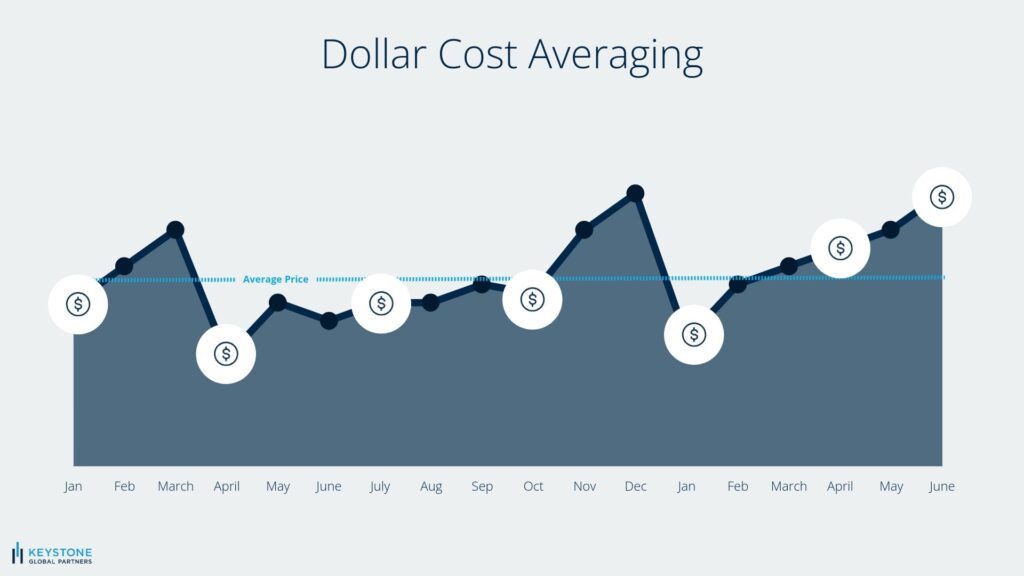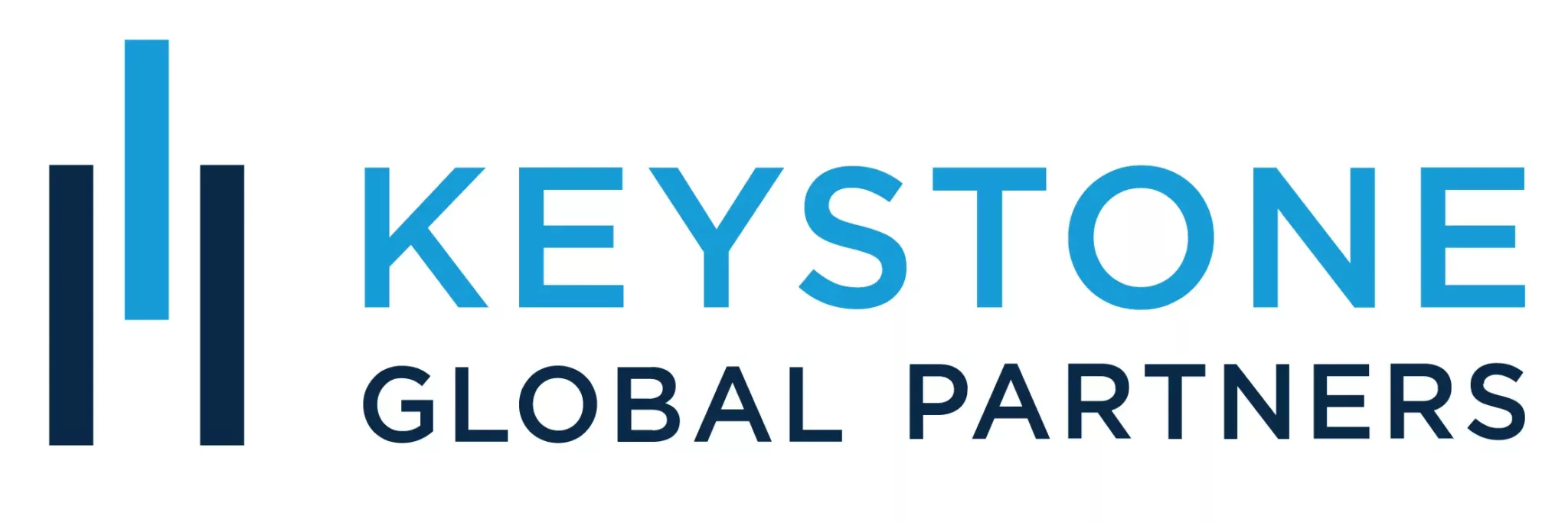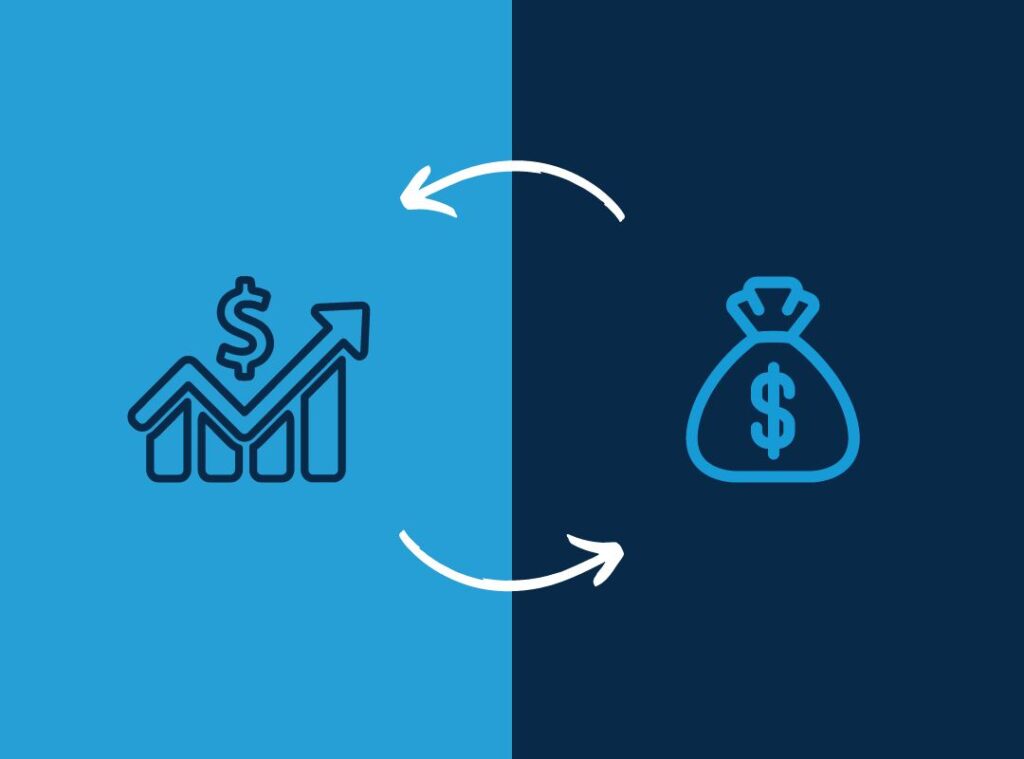When investing a large amount of cash after an exit or liquidity event, the choice between dollar cost averaging vs lump sum investing can be crucial. Each strategy offers distinct advantages, making it vital to grasp the nuances and implications of both in order to make informed investment decisions. In this article, we will explore the comparison between dollar cost averaging vs lump sum investing while also outlining the modified approach we use with our clients at Keystone. The question often arises: “Should we jump right in, or gradually wade into the water?” Let’s dive into the details to help you arrive at the right decision between DCA or lump sum investing.
Dollar Cost Average Investing: Risk Reduction
Dollar cost averaging involves investing a set amount of money at regular intervals, regardless of market conditions. The dollar cost average investing approach aims to mitigate the impact of market volatility by spreading out investments over time. Advocates of dollar cost averaging vs lump sum investing argue that it reduces the risk of investing a large sum at an inopportune moment. For instance, imagine a founder who sold a company and, after taxes, is left with $20 million. By investing $2.5 million each quarter, he would fully deploy his assets within two years. Should a market downturn occur after the first year, there would still be uninvested capital available to deploy at lower market valuations.
Benefits of Dollar Cost Average Investing
- Risk Mitigation: By spreading investments over time, you avoid the risk of deploying all your capital at a market peak.
- Emotional Comfort: Dollar-cost average investing offers emotional reassurance by removing the pressure of timing the market. For first-time founders handling significant amounts of money, decision-making can often feel paralyzing. This strategy makes investing more approachable and manageable.
- Risk Reduction / Hedging: Dollar cost average investing helps minimize the impact of sudden market fluctuations. By investing at regular intervals, you reduce your exposure to potential losses.
- Disciplined Approach: This strategy instills discipline in investors by encouraging consistent contributions to their portfolio over time. It also prevents impulsive decisions based on market sentiments.

Lump Sum Investing: Seizing Opportunities in the Market
On the other hand, a lump sum investment approach involves deploying the entire sum into the market at once. This strategy relies on the belief that time in the market outweighs time not in the market. Research has shown that lump sum investing tends to outperform dollar cost average investing in the long run.
Advantages of Lump Sum Investing
- Optimized Returns: Investing all funds immediately maximizes the time in the market, potentially leading to higher returns.
- Long-Term Growth: Capital deployed earlier has more time to compound and grow.
- Streamlined Approach: Simplifies the investment process by executing a single lump sum investment decision.
Research Insights into DCA or Lump Sum
According to Vanguard’s analysis spanning from 1976 to 2022, the lump sum investment approach outperformed dollar cost averaging 68% of the time after one year. Include 2023 and 2024 YTD and it’s likely higher than that. This research underscores the potential benefits of seizing the investment opportunity upfront rather than spreading it out over time.
Making the Decision Between Lump Sum or Dollar Cost Average: What Works Best for You?
The choice between the lump sum or dollar cost average approach ultimately comes down to your risk tolerance, financial goals, and emotional comfort with market fluctuations. Here are some considerations to keep in mind:
- Comfort with Risk and Behavioral Tendencies: Assess your risk tolerance and determine whether you are comfortable with the potential short-term market fluctuations. Do you suffer from loss aversion?
- Investment Horizon: Consider your investment timeline and whether you aim for short-term gains or long-term growth.
- Market Confidence: Evaluate your confidence in the market’s trajectory and your ability to stay invested during volatile periods.
How We Approach Dollar Cost Averaging vs. Lump Sum Investing
At Keystone, our approach to the decision between dollar cost averaging vs lump sum investing begins with focusing on client education, providing robust data, and conducting stress tests on hypothetical market scenarios. This concept is clearly illustrated through two analytical charts: one displaying the historical timelines during bull markets versus bear markets, and the other demonstrating how portfolios can recover, even when investments are made at inopportune times.
We know our clients’ risk tolerances and their behavioral tendencies. For instance, a client who experiences loss aversion—feeling the pain of a loss more significantly than the pleasure of an equivalent gain—may be a good candidate for dollar cost averaging vs lump sum investing.
Another candidate for dollar cost average investing could be a founder who has recently experienced a liquidity event and lacks substantial investment experience. This individual may encounter considerable challenges during a sudden market sell-off, potentially impacting their long-term investment strategies. Such situations could foster detrimental investment habits that overshadow any potential gains that might have been realized through a lump-sum investment.
Our hybrid approach often involves deploying a larger amount of capital initially (the lump sum investment), followed by dollar cost average investing for the remainder time period. For instance, we might invest 30% upfront and allocate the rest each quarter over the next 18 months. The amounts and timeline will vary based on the specific client and our assessment of what will be most beneficial for them.
We also build in the flexibility to accelerate deployments and capital tranches if the markets experience a sudden selloff. For example, if there is a 10% decline, we can expedite our deployment, and if a subsequent 10% drop occurs, we can fully deploy the remaining funds. We do not believe in market timing, but we do believe that extreme volatility can provide tactical entry points in a situation like this.
During the dollar cost averaging phase while not being fully deployed, we typically invest in a conservative strategy with less equity-like risk, which still generates returns, albeit at a much lower risk profile.
Final Thoughts
Deciding between dollar cost averaging vs lump sum investing is a crucial decision that can impact your investment outcomes. While both strategies have their merits, understanding a client’s risk tolerance is key to making an informed choice. We take a hybrid approach and think of our strategy as a hedge, or rather, a risk reduction strategy and not just a psychological tool.
Whether you prefer the disciplined approach of dollar cost averaging or the good odds of higher returns through lump sum investing, aligning your investment strategy with your goals and risk tolerance is paramount.
In the dynamic landscape of investing, choosing the right approach can pave the way for financial success and growth. Whichever path you choose, staying committed to your investment strategy and maintaining a long-term perspective can help you navigate the complexities of the market with confidence.
FAQs
Which is best, DCA or lump sum?
The answer to this question depends on individual circumstances and risk tolerance. Research has shown that lump sum investing tends to outperform dollar cost average investing in the long run, but dollar cost averaging can provide a more disciplined approach for those who are uncomfortable with market volatility. It is important to evaluate your own goals and comfort level with risk before deciding which approach (lump sum or dollar cost averaging) is best for you. Consulting with a financial advisor can also help you make an informed decision.
Is it better to invest all at once or over time?
The answer to this question depends on individual circumstances. Lump sum investments may provide higher returns in the long run, but dollar cost average investing can help mitigate risk and provide a more disciplined approach. It’s important to consider your investment horizon, risk tolerance, and market confidence when deciding between dollar cost averaging vs lump sum investing. Consulting with a financial advisor can also help you make an informed decision based on your specific goals and needs. Overall, it is crucial to align your investment strategy with your personal goals and comfort level with risk to achieve success in the dynamic world of investing.


